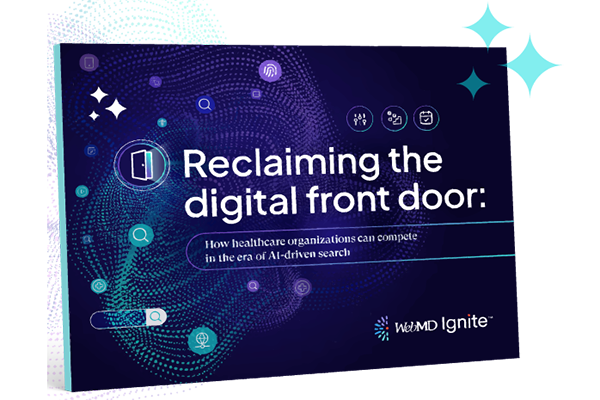Healthcare marketing FAQ

Editor's Note: This blog was published prior to the transition to WebMD Ignite.
Frequently asked questions: What is healthcare marketing?
Definition of healthcare marketing
Healthcare marketing is a process of strategic outreach and communications designed to attract healthcare consumers, guide them through their healthcare journey, and keep them engaged with the health system.
Sophisticated healthcare marketing strategies integrate omnichannel, highly-segmented, and targeted online and offline tactics to drive engagement and accelerate enterprise growth. Health systems measure the success of their marketing efforts through specific metrics that are aligned with key performance indicators (KPIs), and/or marketing return on investment (ROI).
Benefits of healthcare marketing
- Find prospective patients with business objectives in mind, i.e. a healthy payer mix or high-value service line growth
- Increase strategic advantage to attract patients in a hypercompetitive landscape
- Keep patients engaged with relevant, personalized, and timely outreach throughout their journeys
- Retain patients long-term and improve loyalty in your healthcare community
- Drive more qualified leads, generate revenue with healthy margins
- Connect with patients across multiple channels
- Evaluate productivity and re-align strategy with comprehensive healthcare data analytics
- Building Your Healthcare Marketing Strategy
The ever-evolving healthcare landscape can present unfamiliar challenges to even the most seasoned marketers. Marketing teams need to keep up with the latest industry tips and trends to ensure they’re crafting an engaging and effective strategy that maximizes their impact on the health system’s bottom line.
1. Create a seamless digital patient experience
Today’s consumers expect to engage on their own terms. A high-quality healthcare marketing strategy must pay close attention to the patient experience and allow them to enter your health system through their preferred channels. Start by identifying the many places the patients typically begin engaging with your health system. These introductory touch points, collectively referred to as the digital front door, could include channels like your health system’s website, third-party physician listings, or your engagement center—just to name a few.
Outline the path a patient is most likely to take after their first engagement with your health system, whether it results in a conversion or not. This practice, called patient journey mapping, will help you understand which actions lead to conversions, and which actions may cause a patient to exit the journey. Ideally, you will want to map multiple journeys across service lines, working with clinicians, revenue cycle specialists, and other patient-facing staff to capture entire care episodes and identify friction.
2. Build a consistent brand
Consumers don’t buy products or services they don’t know or trust. Similarly, consumers won’t choose a hospital or care team that they’re unfamiliar with. Building a strong brand and promoting brand awareness helps reduce overall cost-per-acquisition, so make sure to allocate an appropriate budget to brand building.
Think about what makes your health system unique, and what draws customers in. Is it high- quality care? Caring staff? Cutting-edge technology? A high degree of trust? Find one crucial factor that attracts patients, and design marketing campaigns to spread awareness and activate your brand. Promoting your hard-won quality achievements is one of the most effective ways to build a trusting brand image.
3. Build engaging relationships using personalization
Despite the personal nature of healthcare, many marketing strategies have not integrated personalization. Marketers should leverage the clinical data contained in their electronic health record (EHR) system and consumer and behavioral data in their healthcare customer relationship management (CRM) software to laser-target patients who need their services.
4. Create a strong website
High-quality hospital websites help optimize the patient journey in a few key ways. They constantly collect important consumer data used for a variety of marketing purposes, like remarketing campaigns or fueling personalization in digital spaces. Modern websites are also great vehicles for delivering personalized experiences through dynamic copy and creative. Finally, they provide a central location for your content, which makes it easy for patients to learn more about your health system and quickly find the right doctor and location for their needs.
Additionally, the SEO value of a strong website should not be overlooked. A good website provider should tout benefits like optimized site speeds and responsive design to ensure search engines look favorably upon your health system. This is crucial to help patients find your health system’s official site with ease.
5. Evaluate the best marketing channels
Healthcare marketers juggle a variety of channels for marketing purposes, including organic search, paid search, social media, display ads, and more—and a single marketing budget to distribute. Making the most out of countless marketing channels can be overwhelming. A business intelligence solution will help your teams use data to discover the most influential marketing channels for different geographic areas, personas, and service lines.
6. Manage patient reviews
Research has uncovered that 59% of Americans find patient reviews to be very important or somewhat important when choosing a physician. It’s clear the majority of patients want to see others have had a good experience with you before they entrust you with their own health. For this reason, it is crucial that health systems solicit positive reviews from satisfied patients.
However, receiving a few negative reviews is inevitable. Health systems that wish to maintain a favorable reputation must respond to these reviews in a way that is HIPAA compliant and empathetic. Even if a patient assesses their experience in a way that is brutally honest, remember to thank them for their feedback, address their concern directly, and communicate how you plan to resolve their concern.
7. Use analytics to secure your budget
Marketing teams often receive their budget from upper-level management. Unfortunately, assigning budgets in this way typically results in over or under-spending, which can diminish the marketing team’s impact on the health system. Instead, marketers should analyze previous campaigns, determine how much budget is needed to reach key demographics, and present findings to executives for buy-in.
8. Align marketing with organizational objectives
Marketing needs to have a seat at the table when determining the health system’s overall business strategy. Opening up a two-way dialogue between marketing and upper-level management will enable marketers to understand that organization’s overarching goals. Then, they can use analytics to set a realistic budget to achieve these goals.
9. Analyze your market
Understanding rapidly shifting market dynamics matters more than ever, given ongoing consolidation of traditional providers and the growing number of new entrants intent on disrupting existing models. With advanced healthcare business intelligence built on the largest repository of healthcare-specific data, decision-makers responsible for driving business growth can understand interlocking market dynamics such as consumer need, market share, physician alignment, and competitive dynamics.
For an even greater competitive advantage, harness the power of claims-based analytics to identify patient activity across inpatient and outpatient settings, so planners can understand not just market share but share of care at the procedure level, for the entire pre- and post-surgical patient journey.
Common healthcare marketing questions
Why is healthcare marketing important?
Healthcare is changing. Consumers are now more actively involved in their care than ever before, making key decisions along their healthcare journey that they may have formerly left to a physician. Internet research is on the rise, “Dr. Google” is gaining authority, and healthcare consumers even spend time comparing prices and testimonials prior to selecting a healthcare provider.
In addition, consumers look to non-traditional remedies before scheduling an appointment with their PCP. In fact, 63 percent of consumers received care from a non-traditional provider in 2018, such as a retail or walk-in clinic, virtual care provider, or outpatient hospital. Convenience trumps other factors, such as provider history or background, but patients still want to receive a level of personalized care that conveys trust and accountability in the health system.
Changes in consumer behavior is a key factor driving the increased importance of marketing. The effective marketing messaging must convey is no longer about offering a better quality of care: It’s about providing convenient, accessible, digitally integrated services that fit into consumers’ hectic lives. For this reason, the healthcare marketers, the experts in communication and channel strategy, hold a more critical role than previous decades.
Healthcare marketing supports this transition to consumer-driven care by educating patients, drawing them into health systems, and providing the superior customer service and engagement opportunities necessary to maintain patient loyalty.
What technology is necessary for success in healthcare marketing?
There are four major marketing technology platforms that healthcare organizations need in order to develop and execute impactful healthcare marketing campaigns:
Healthcare customer relationship management (CRM)
A CRM platform integrates patient data from a variety of sources to help marketers build, launch, optimize, and measure multichannel healthcare campaigns. With a CRM, it is possible to personalize marketing outreach in ways that enrich patient engagements, improve customer service, and encourage long-term relationships. Sophisticated CRMs also integrate with other technology platforms, including the EMR and financial systems, to support a comprehensive, data-driven outreach strategy.
Content management system (CMS)
A CMS streamlines and classifies healthcare marketing content, as well as integrates with a CRM to create guidelines that ensure future content aligns with brand guidelines. A CMS can also create a procedure for content repurposing and reusability to help healthcare marketers distribute content efficiently.
Marketing automation
A marketing automation platform allows healthcare marketers to automate the distribution of content to the right patients, at exactly the right time. This software leverages CRM data to ensure each customer journey is unique and based on real-time data and triggers. These limitless campaign triggers are stage-driven and based on an individual’s behavior or sequence of action. Marketing automation software is often used to deploy repetitive communications such as email, social media, and even paid advertising campaigns.
Engagement center
An Engagement Center is an optimized call center that supports highly personalized, world-class patient experiences delivered on-the-fly for inbound and outbound calls. An engagement center solution integrates CRM data to provide representatives with a comprehensive 360° view of each caller, including records of past engagements – both over the phone and online. Armed with this information, call center representatives can have relevant and personalized conversations that solidify the patient’s relationship with the health system.
Together, these four technologies enable smarter patient acquisition and retention by nurturing patients with personalized, timely, and relevant content. This technology, coupled with a carefully enacted precision marketing strategy, increases conversions, strengthens retention rates, extends patient lifetime value, and improves year-over-year growth.
What is the TCO for healthcare marketing technology?
Total cost of ownership is defined as the purchase price of an asset plus the costs of operation. In other words, it is the sum of all direct and indirect costs incurred when purchasing a piece of technology. TCO is often used alongside ROI calculation when initiating a project, and considers expenses involved with implementation, upkeep, support, compliance, and etc.
When evaluating healthcare marketing technology, TCO analysis should be part of the research and vendor-partner selection process. In general, there are three key categories of cost that go into a comprehensive TCO analysis for healthcare software: Acquisition costs, operational costs, and resources (personnel) costs. To calculate total cost of ownership for healthcare marketing software, simply combine these components using the following formula:
TCO = [(OC + RC) x Y] + AC
Where:
- OC = Operational Costs (per year)
- RC = Resources Costs (per year)
- Y = Years of Ownership (estimated)
- AC = Acquisition Costs
What are the challenges to successful healthcare marketing?
There are three main barriers preventing healthcare marketing success: departmental silos, outdated tactics and technology, and insufficient budgets.
Departmental silos prevent healthcare marketers from delivering a consistent stream of communication to patients, which is necessary to meet the quality and cost demands of healthcare reform. To remain competitive in the years to come, healthcare marketers must evolve alongside today’s fast-paced digital world, including the use of newer digital channels.
Additionally, budgetary constraints often hold healthcare marketers back. While the median hospital marketing budget is $3.1 million, while retail healthcare providers like CVS spend more than $100 million on marketing. To make the most of their modest budget, healthcare marketers need to find innovative ways to stay competitive with their allotted spend.
How can health systems improve their healthcare marketing strategy?
Improving marketing efforts requires leveraging the wealth of consumer and market data available—such as consumer, household, and socio-behavioral data stored within the CRM—crafting individualized patient messaging according to unique patient personas, executing on omnichannel precision marketing strategies, and constantly optimizing marketing performance through real-time campaign intelligence. Today’s consumers are increasingly motivated by convenience and personalization. Marketers must be cognizant of these desires and create rich, compelling content and communications that make it easier for patients to find and receive medical care.
Are there any HIPAA concerns with remarketing?
Typically, there are no HIPAA concerns with remarketing. In certain instances, however, it could be perceived as blurring the line. We recommend limiting landing page forms to require only basic contact information, such as first and last name and an email address. As long as you’re not collecting medical or clinical information, you’re not violating PHI or HIPAA, so remarketing shouldn’t be an issue.
Will implementing a marketing automation tool impact the marketing structure?
Similar to adopting a healthcare CRM solution, to get the most out of the investment, healthcare marketing departments should designate at least one, dedicated employee to be responsible for implementing and operating a marketing automation tool. This should be a more technically-oriented individual who is primarily responsible for working in the solution—i.e.,. a power user.
As far as the rest of the marketing department, it is likely that your team structure will shift and evolve simply because marketing automation systems provide a greater degree of efficiency and allows organizations to execute smarter patient acquisition and retention programs. If, for example, there were 4-5 people within the marketing department doing a job that marketing automation software can now handle, these individuals are freed up to dedicate more time to more strategic, value-add activities, projects, and initiatives.




